Haobo Jiang
Mask6D: Masked Pose Priors For 6D Object Pose Estimation
Jul 09, 2025Abstract:Robust 6D object pose estimation in cluttered or occluded conditions using monocular RGB images remains a challenging task. One reason is that current pose estimation networks struggle to extract discriminative, pose-aware features using 2D feature backbones, especially when the available RGB information is limited due to target occlusion in cluttered scenes. To mitigate this, we propose a novel pose estimation-specific pre-training strategy named Mask6D. Our approach incorporates pose-aware 2D-3D correspondence maps and visible mask maps as additional modal information, which is combined with RGB images for the reconstruction-based model pre-training. Essentially, this 2D-3D correspondence maps a transformed 3D object model to 2D pixels, reflecting the pose information of the target in camera coordinate system. Meanwhile, the integrated visible mask map can effectively guide our model to disregard cluttered background information. In addition, an object-focused pre-training loss function is designed to further facilitate our network to remove the background interference. Finally, we fine-tune our pre-trained pose prior-aware network via conventional pose training strategy to realize the reliable pose prediction. Extensive experiments verify that our method outperforms previous end-to-end pose estimation methods.
Diff-Reg v2: Diffusion-Based Matching Matrix Estimation for Image Matching and 3D Registration
Mar 07, 2025



Abstract:Establishing reliable correspondences is crucial for all registration tasks, including 2D image registration, 3D point cloud registration, and 2D-3D image-to-point cloud registration. However, these tasks are often complicated by challenges such as scale inconsistencies, symmetry, and large deformations, which can lead to ambiguous matches. Previous feature-based and correspondence-based methods typically rely on geometric or semantic features to generate or polish initial potential correspondences. Some methods typically leverage specific geometric priors, such as topological preservation, to devise diverse and innovative strategies tailored to a given enhancement goal, which cannot be exhaustively enumerated. Additionally, many previous approaches rely on a single-step prediction head, which can struggle with local minima in complex matching scenarios. To address these challenges, we introduce an innovative paradigm that leverages a diffusion model in matrix space for robust matching matrix estimation. Our model treats correspondence estimation as a denoising diffusion process in the matching matrix space, gradually refining the intermediate matching matrix to the optimal one. Specifically, we apply the diffusion model in the doubly stochastic matrix space for 3D-3D and 2D-3D registration tasks. In the 2D image registration task, we deploy the diffusion model in a matrix subspace where dual-softmax projection regularization is applied. For all three registration tasks, we provide adaptive matching matrix embedding implementations tailored to the specific characteristics of each task while maintaining a consistent "match-to-warp" encoding pattern. Furthermore, we adopt a lightweight design for the denoising module. In inference, once points or image features are extracted and fixed, this module performs multi-step denoising predictions through reverse sampling.
Diff-Reg v1: Diffusion Matching Model for Registration Problem
Mar 29, 2024
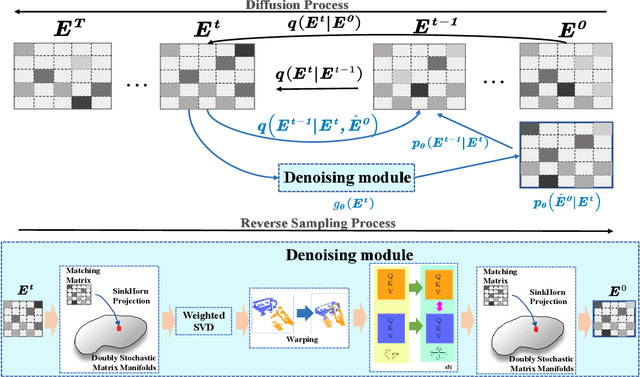
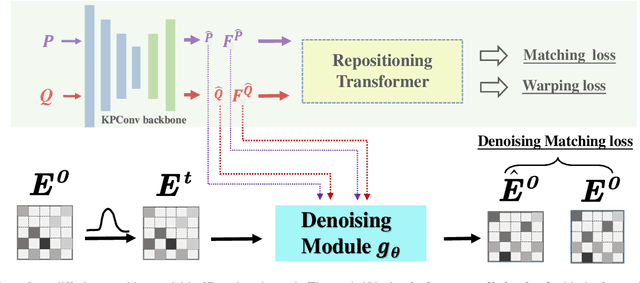
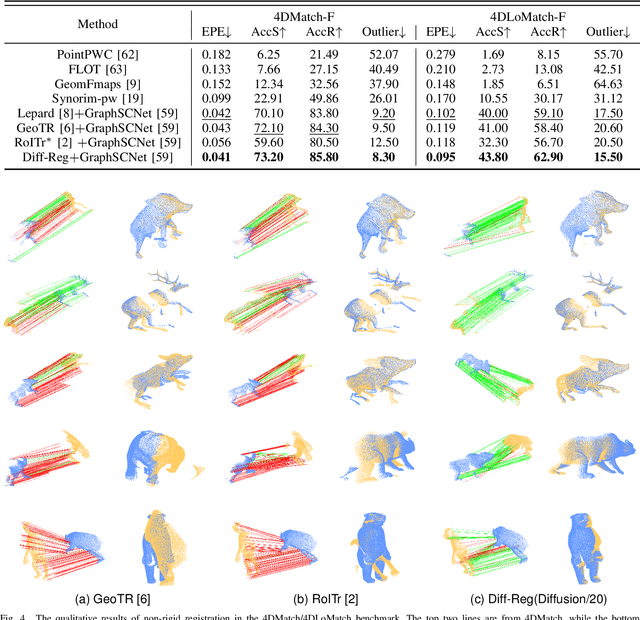
Abstract:Establishing reliable correspondences is essential for registration tasks such as 3D and 2D3D registration. Existing methods commonly leverage geometric or semantic point features to generate potential correspondences. However, these features may face challenges such as large deformation, scale inconsistency, and ambiguous matching problems (e.g., symmetry). Additionally, many previous methods, which rely on single-pass prediction, may struggle with local minima in complex scenarios. To mitigate these challenges, we introduce a diffusion matching model for robust correspondence construction. Our approach treats correspondence estimation as a denoising diffusion process within the doubly stochastic matrix space, which gradually denoises (refines) a doubly stochastic matching matrix to the ground-truth one for high-quality correspondence estimation. It involves a forward diffusion process that gradually introduces Gaussian noise into the ground truth matching matrix and a reverse denoising process that iteratively refines the noisy matching matrix. In particular, the feature extraction from the backbone occurs only once during the inference phase. Our lightweight denoising module utilizes the same feature at each reverse sampling step. Evaluation of our method on both 3D and 2D3D registration tasks confirms its effectiveness.
Diff-PCR: Diffusion-Based Correspondence Searching in Doubly Stochastic Matrix Space for Point Cloud Registration
Jan 17, 2024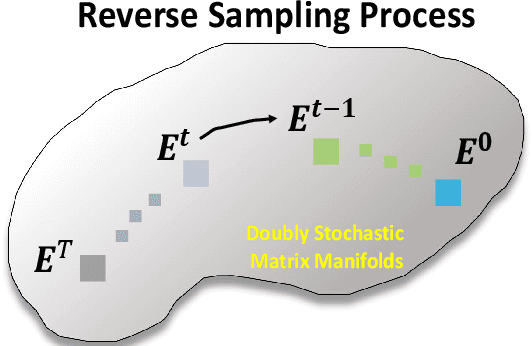
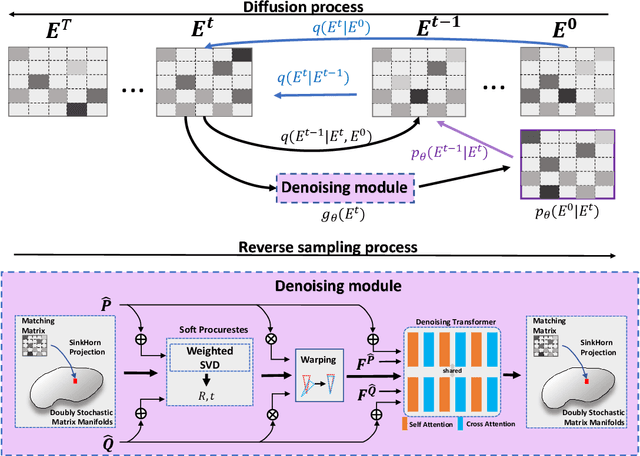
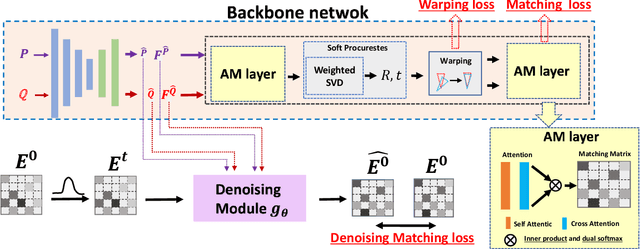
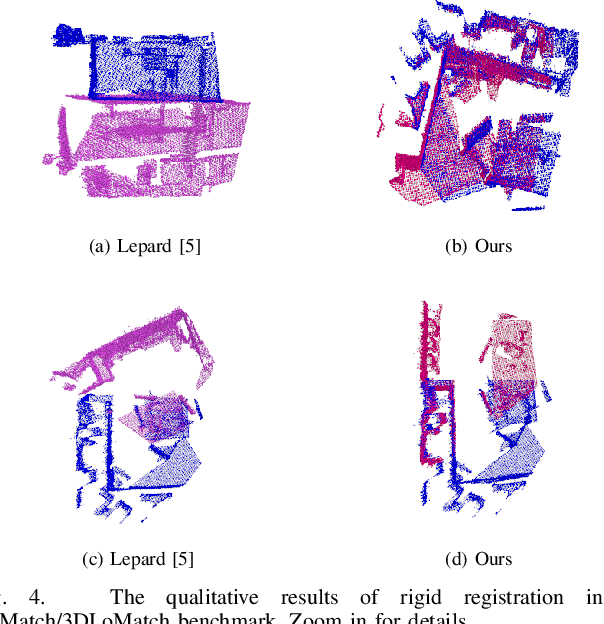
Abstract:Efficiently finding optimal correspondences between point clouds is crucial for solving both rigid and non-rigid point cloud registration problems. Existing methods often rely on geometric or semantic feature embedding to establish correspondences and estimate transformations or flow fields. Recently, state-of-the-art methods have employed RAFT-like iterative updates to refine the solution. However, these methods have certain limitations. Firstly, their iterative refinement design lacks transparency, and their iterative updates follow a fixed path during the refinement process, which can lead to suboptimal results. Secondly, these methods overlook the importance of refining or optimizing correspondences (or matching matrices) as a precursor to solving transformations or flow fields. They typically compute candidate correspondences based on distances in the point feature space. However, they only project the candidate matching matrix into some matrix space once with Sinkhorn or dual softmax operations to obtain final correspondences. This one-shot projected matching matrix may be far from the globally optimal one, and these approaches do not consider the distribution of the target matching matrix. In this paper, we propose a novel approach that exploits the Denoising Diffusion Model to predict a searching gradient for the optimal matching matrix within the Doubly Stochastic Matrix Space. During the reverse denoising process, our method iteratively searches for better solutions along this denoising gradient, which points towards the maximum likelihood direction of the target matching matrix. Our method offers flexibility by allowing the search to start from any initial matching matrix provided by the online backbone or white noise. Experimental evaluations on the 3DMatch/3DLoMatch and 4DMatch/4DLoMatch datasets demonstrate the effectiveness of our newly designed framework.
SE(3) Diffusion Model-based Point Cloud Registration for Robust 6D Object Pose Estimation
Oct 26, 2023Abstract:In this paper, we introduce an SE(3) diffusion model-based point cloud registration framework for 6D object pose estimation in real-world scenarios. Our approach formulates the 3D registration task as a denoising diffusion process, which progressively refines the pose of the source point cloud to obtain a precise alignment with the model point cloud. Training our framework involves two operations: An SE(3) diffusion process and an SE(3) reverse process. The SE(3) diffusion process gradually perturbs the optimal rigid transformation of a pair of point clouds by continuously injecting noise (perturbation transformation). By contrast, the SE(3) reverse process focuses on learning a denoising network that refines the noisy transformation step-by-step, bringing it closer to the optimal transformation for accurate pose estimation. Unlike standard diffusion models used in linear Euclidean spaces, our diffusion model operates on the SE(3) manifold. This requires exploiting the linear Lie algebra $\mathfrak{se}(3)$ associated with SE(3) to constrain the transformation transitions during the diffusion and reverse processes. Additionally, to effectively train our denoising network, we derive a registration-specific variational lower bound as the optimization objective for model learning. Furthermore, we show that our denoising network can be constructed with a surrogate registration model, making our approach applicable to different deep registration networks. Extensive experiments demonstrate that our diffusion registration framework presents outstanding pose estimation performance on the real-world TUD-L, LINEMOD, and Occluded-LINEMOD datasets.
Implicit Obstacle Map-driven Indoor Navigation Model for Robust Obstacle Avoidance
Aug 24, 2023



Abstract:Robust obstacle avoidance is one of the critical steps for successful goal-driven indoor navigation tasks.Due to the obstacle missing in the visual image and the possible missed detection issue, visual image-based obstacle avoidance techniques still suffer from unsatisfactory robustness. To mitigate it, in this paper, we propose a novel implicit obstacle map-driven indoor navigation framework for robust obstacle avoidance, where an implicit obstacle map is learned based on the historical trial-and-error experience rather than the visual image. In order to further improve the navigation efficiency, a non-local target memory aggregation module is designed to leverage a non-local network to model the intrinsic relationship between the target semantic and the target orientation clues during the navigation process so as to mine the most target-correlated object clues for the navigation decision. Extensive experimental results on AI2-Thor and RoboTHOR benchmarks verify the excellent obstacle avoidance and navigation efficiency of our proposed method. The core source code is available at https://github.com/xwaiyy123/object-navigation.
Robust Outlier Rejection for 3D Registration with Variational Bayes
Apr 04, 2023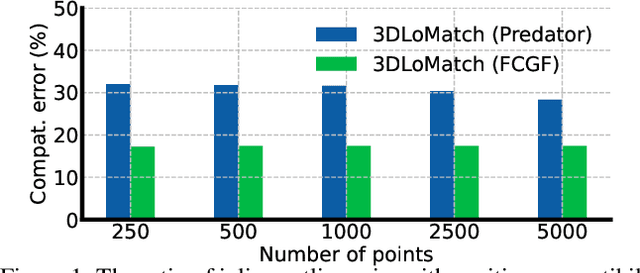

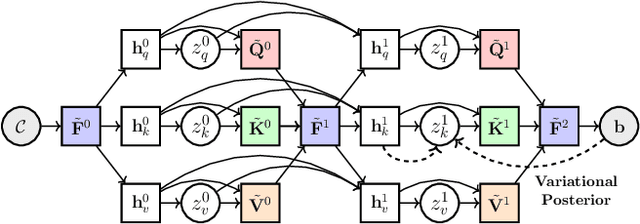
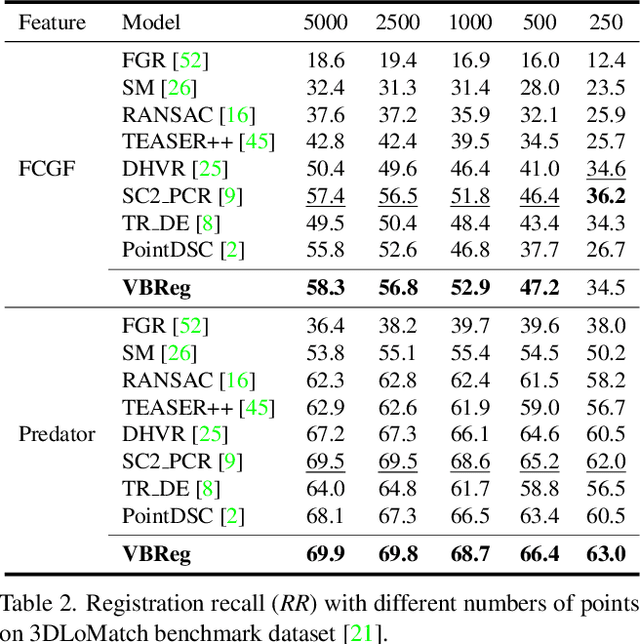
Abstract:Learning-based outlier (mismatched correspondence) rejection for robust 3D registration generally formulates the outlier removal as an inlier/outlier classification problem. The core for this to be successful is to learn the discriminative inlier/outlier feature representations. In this paper, we develop a novel variational non-local network-based outlier rejection framework for robust alignment. By reformulating the non-local feature learning with variational Bayesian inference, the Bayesian-driven long-range dependencies can be modeled to aggregate discriminative geometric context information for inlier/outlier distinction. Specifically, to achieve such Bayesian-driven contextual dependencies, each query/key/value component in our non-local network predicts a prior feature distribution and a posterior one. Embedded with the inlier/outlier label, the posterior feature distribution is label-dependent and discriminative. Thus, pushing the prior to be close to the discriminative posterior in the training step enables the features sampled from this prior at test time to model high-quality long-range dependencies. Notably, to achieve effective posterior feature guidance, a specific probabilistic graphical model is designed over our non-local model, which lets us derive a variational low bound as our optimization objective for model training. Finally, we propose a voting-based inlier searching strategy to cluster the high-quality hypothetical inliers for transformation estimation. Extensive experiments on 3DMatch, 3DLoMatch, and KITTI datasets verify the effectiveness of our method.
Recurrent Structure Attention Guidance for Depth Super-Resolution
Jan 31, 2023



Abstract:Image guidance is an effective strategy for depth super-resolution. Generally, most existing methods employ hand-crafted operators to decompose the high-frequency (HF) and low-frequency (LF) ingredients from low-resolution depth maps and guide the HF ingredients by directly concatenating them with image features. However, the hand-designed operators usually cause inferior HF maps (e.g., distorted or structurally missing) due to the diverse appearance of complex depth maps. Moreover, the direct concatenation often results in weak guidance because not all image features have a positive effect on the HF maps. In this paper, we develop a recurrent structure attention guided (RSAG) framework, consisting of two important parts. First, we introduce a deep contrastive network with multi-scale filters for adaptive frequency-domain separation, which adopts contrastive networks from large filters to small ones to calculate the pixel contrasts for adaptive high-quality HF predictions. Second, instead of the coarse concatenation guidance, we propose a recurrent structure attention block, which iteratively utilizes the latest depth estimation and the image features to jointly select clear patterns and boundaries, aiming at providing refined guidance for accurate depth recovery. In addition, we fuse the features of HF maps to enhance the edge structures in the decomposed LF maps. Extensive experiments show that our approach obtains superior performance compared with state-of-the-art depth super-resolution methods.
Structure Flow-Guided Network for Real Depth Super-Resolution
Jan 31, 2023



Abstract:Real depth super-resolution (DSR), unlike synthetic settings, is a challenging task due to the structural distortion and the edge noise caused by the natural degradation in real-world low-resolution (LR) depth maps. These defeats result in significant structure inconsistency between the depth map and the RGB guidance, which potentially confuses the RGB-structure guidance and thereby degrades the DSR quality. In this paper, we propose a novel structure flow-guided DSR framework, where a cross-modality flow map is learned to guide the RGB-structure information transferring for precise depth upsampling. Specifically, our framework consists of a cross-modality flow-guided upsampling network (CFUNet) and a flow-enhanced pyramid edge attention network (PEANet). CFUNet contains a trilateral self-attention module combining both the geometric and semantic correlations for reliable cross-modality flow learning. Then, the learned flow maps are combined with the grid-sampling mechanism for coarse high-resolution (HR) depth prediction. PEANet targets at integrating the learned flow map as the edge attention into a pyramid network to hierarchically learn the edge-focused guidance feature for depth edge refinement. Extensive experiments on real and synthetic DSR datasets verify that our approach achieves excellent performance compared to state-of-the-art methods.
Point Cloud Registration-Driven Robust Feature Matching for 3D Siamese Object Tracking
Sep 14, 2022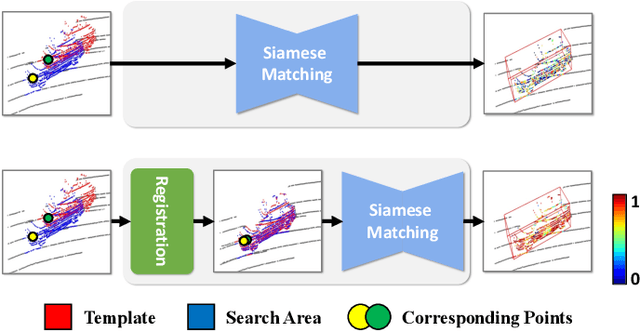


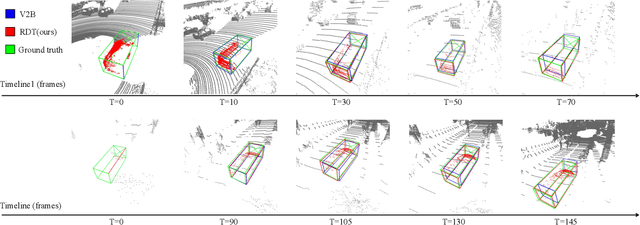
Abstract:Learning robust feature matching between the template and search area is crucial for 3D Siamese tracking. The core of Siamese feature matching is how to assign high feature similarity on the corresponding points between the template and search area for precise object localization. In this paper, we propose a novel point cloud registration-driven Siamese tracking framework, with the intuition that spatially aligned corresponding points (via 3D registration) tend to achieve consistent feature representations. Specifically, our method consists of two modules, including a tracking-specific nonlocal registration module and a registration-aided Sinkhorn template-feature aggregation module. The registration module targets at the precise spatial alignment between the template and search area. The tracking-specific spatial distance constraint is proposed to refine the cross-attention weights in the nonlocal module for discriminative feature learning. Then, we use the weighted SVD to compute the rigid transformation between the template and search area, and align them to achieve the desired spatially aligned corresponding points. For the feature aggregation model, we formulate the feature matching between the transformed template and search area as an optimal transport problem and utilize the Sinkhorn optimization to search for the outlier-robust matching solution. Also, a registration-aided spatial distance map is built to improve the matching robustness in indistinguishable regions (e.g., smooth surface). Finally, guided by the obtained feature matching map, we aggregate the target information from the template into the search area to construct the target-specific feature, which is then fed into a CenterPoint-like detection head for object localization. Extensive experiments on KITTI, NuScenes and Waymo datasets verify the effectiveness of our proposed method.
 Add to Chrome
Add to Chrome Add to Firefox
Add to Firefox Add to Edge
Add to Edge